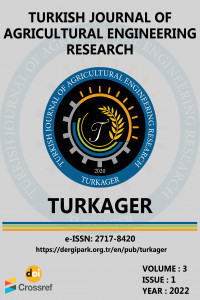Development and Performance Evaluation of a Hand Operated Maize Sheller
Development and Performance Evaluation of a Hand Operated Maize Sheller
Crank, Stripping chute, Sheller Multivariate data, Shelling capacity,
___
- Ajav EA, Okusanya MA and Obi OF (2018). Jatropha oil extraction optimization through varied processing conditions using mechanical process. International Journal of Innovative Research & Development, 7(9): 227-241. https.//doi.org/10.24940/Ijird/2018/V7/I9/Sep18058.
- Azeez TM, Uchegbu ID, Babalola SA and Odediran OO (2017). Performance evaluation of a developed maize sheller. Journal of Advancement in Engineering and Technology. Afe Babalola Repository.
- Amare D, Endalew W, Yayu N, Endeblihatu A, Biweta W, Tefera A and Tekeste S (2017). Evaluation and demonstration of maize shellers for small-scale farmers. MOJ Applied and Biomechanics, 1(3): 0014. https.//doi.org/10.15406/mojabb.2017.01.00014.
- Belonio AT (2004). Agricultural power and energy sources. Department of Agricultural Engineering and Environmental Management, College of Agricultur, Central Philippines University, Iloilo. City.
- Boluwade E. and Smith G. (2022). Grain and Feed Update. United State Department of Agriculture: Foreign Agricultural Service and Global Agricultural Network.
- Dagninet A, Fentahun T and Abu T (2008). On-farm evaluation and verification of maize–sorghum thresher. Proceedings of the 3rd Annual Regional Conference on Completed Research Activities on Soil and Water Management, Forestry and Agricultural Mechanization, 1-4 September, 2008. Ethiopia: ARARI
- Danilo M (2003). Maize: Post-Harvest operation. https://www.aflatoxinpartnership.org/wp-content/uploads/2021/05/Maize-importance-globaly.pdf. FAO technical Report, Ethiopia. Accessed May, 2022.
- IITA (2020). IITA-BIP Sets record for maize production per hectare in Nigeria. https://www.iita.org/news-item/iita-bip-sets-record-for-maize-production-per-hectare-in-nigeria/. Accessed May, 2022.
- Okojie J (2022). Bridging the Nigeria’s maize shortfall. https://businessday.ng/agriculture/article/bridging-nigerias-maize-supply-shortfall/. Accessed June, 2022.
- Okusanya MA and Oladigbolu AA (2020). Development of a motorised thresher for paddy rice processing. International Journal of Scientific & Engineering Research (IJSER), 11(2): 821-836.
- Rajender G, Anubabu T, Krishna CH, Ali MDM, Thirupathi CH and Vinod V (2018). Performance evaluation of hand operated maize sheller. International Journal of Agricultural Science, 10(7): 5676-5678.
- Sedara E, Odediran E and Manuwa S (2021). Design and fabrication of an ımproved motorized maize sheller/threshing machine. Journal of Engineering Studies and Research, 26(4): 120-131. https://doi.org/10.29081/jesr.v26i4.244
- USDA (2022). Nigeria’s maize production at highest level since independence. United States Department of Agriculture. Foreign Agricultural Service. https://www.fas.usda.gov/data/nigeria- grain-and-feed-annual-5
- Zach A (2020). Statology. https://www.statology.org/author/admin/ Access June, 2022.
- Yayın Aralığı: Yılda 2 Sayı
- Başlangıç: 2020
- Yayıncı: Ebubekir ALTUNTAŞ
Uğur ÖZKAN, Nesim YILDIZ, Celal PEKER
Mathematically Predicting the Performance Rate of Plow-Type Trenchless Machine
Abdelgawad SAAD, Hani MANSOUR, Elsayed ALİ, Mostafa AZAM
Development and Performance Evaluation of a Hand Operated Maize Sheller
Muyıwa OKUSANYA, Francis AGBONGİABAN
Development of a Cowpea Threshing Machine
Mohamed MANSOUR SHALABY REFAAAY, Ahmed SHAWKY EL-SAYED, Mokhtar COTTB AHMED AWAD
Simulation-Optimization Modelling of Yield and Yield Components of Tomato Crop
Nura Jafar SHANONO, Lawal AHMAD, Nuraddeen Mukhtar NASİDİ, Abdul'aziz Nuhu JİBRİL, Mukhtar Nuhu YAHYA
Maney Ayalew DESTA, Getachew Shunki TİBBA, Mubarek Mohammed ISSA, Wariso HEYİ
A microcontroller - Based Irrigation Scheduling Using FAO Penman-Monteith Equation
Olugbenga Kayode OGİDAN, Samuel Dare OLUWAGBAYIDE, Thomas ALE
